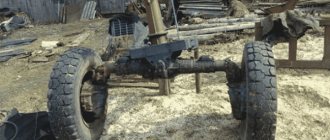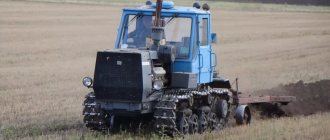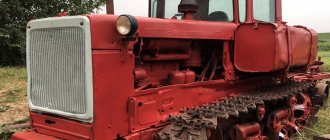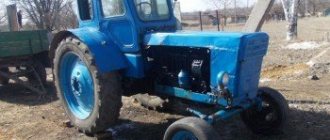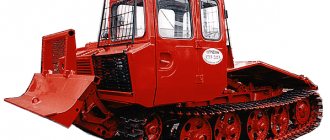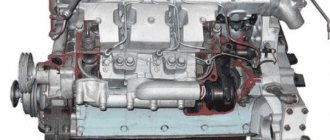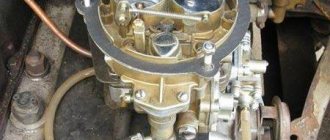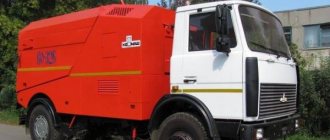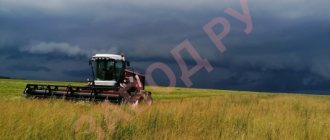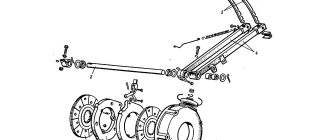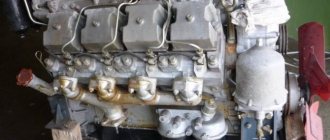A little about the T-40 tractor
The T-40 tractor (“magpie”) is a wheeled tractor produced at the Lipetsk Tractor Plant from 1961 to 1995.
Production of this model is currently discontinued. During production, over 1.196 million similar tractors were assembled. The T-40, also known as the “magpie,” belongs to the 0.9 class of wheeled tractors. In the period from 1961 to 1995, it was produced at the tractor plant in Lipetsk. During this period, more than a million copies were released. The main activities are agricultural, transportation and repair and construction work with the aggregation of auxiliary mechanisms and structures. If necessary, you can attach a mower, snowblower, bale packer, plowing equipment and a compact loader. The versatility of application and a wide selection of additional functions allows you to cover a significant amount of work. Popular in farming.
The presence of a reversible mechanical transmission allows you to cover the full range of speeds when moving backwards or forwards. Supports aggregation with spare parts and devices from both light equipment (for example, T-25) and heavy equipment (MTZ-80). This makes it more versatile and popular not only in the CIS, but also beyond its borders.
During the existence of the model, a significant number of versions and modifications were released, the main differences of which were the power units used.
Among the most popular:
- Modification with all-wheel drive T-40A.
- Its lowered version of the T-40AN with a small distance between the bottom and the road surface - for performing tasks on inclined planes;
- Industrial version of the T-50A, equipped with a loader;
- Equipped with rear wheel drive T-40M.
- With all-wheel drive T-40AM.
Repair of the T-40 tractor: Main technical parameters
- Two types of engines are used: D-37 and D-144. Engine power, depending on the choice, reaches from 35 to 50 horsepower.
- The maximum speed is 26 km/h, and the minimum is 2.2 km/h. When using a special slow transmission, the speed is halved to 1.1 km/h.
- Dimensions: length - 366 cm, width - 162 cm, height 210 cm.
- The clearance between the road and the bottom is 50 cm.
- Weight 2.5 tons.
- Average fuel consumption is 120 g/minute. Proper and timely maintenance of the engine significantly extends its service life.
Repair of the T-40 tractor: A set of tips for proper operation:
- A new or recently overhauled engine should not be operated under heavy load until it has undergone a preliminary break-in.
- It is not recommended to operate at low oil pressure.
- Do not overload the engine with prolonged operation.
- The fan must have a casing.
- Use only suitable fuel and oil.
- Prolonged idle mode should not be allowed.
- Do not operate if the oil temperature is below 55 degrees.
- Use the device only if you have a working air purifier.
- Do not overheat above 100 degrees.
Repair of the T-40 tractor: Positive and negative qualities of the T-40
- Problematic operation at low temperatures.
- Weak cooling system.
- Lack of air conditioning.
- — Simplicity and reliability.
- High cross-country ability and maneuverability.
- Good degree of compatibility with attachments.
Repair of the T-40 tractor: Average cost of equipment
Download repair manuals for the T-40 tractor
Tractors T-40M, T-40AM, T-40ANM. Practical guide to repairing the T-40 tractor
Author: ed. Pedchenets N.A. Year of release: 1988 Format: zip (6 MB) Brief description:
The book describes the design of the T-4OM, T-40AM and T-40ANM tractors and their mechanisms. Instructions for their adjustment are given. Rules for operating tractors and maintenance methods are given. Possible malfunctions are listed and ways to eliminate them are given. The book is intended for tractor drivers, as well as for persons associated with the operation and maintenance of T-40M tractors,
Tractors T-40M, T-40AM, T-40ANM
(repair of the T-40 tractor) Author: ed. Vinogradova K.N. Year of release: 1976 Format: rar (5 MB) Brief description: The book, written by a group of leading engineers from the department of the chief designer of the Lipetsk Tractor Plant, covers the design and adjustment of components and mechanisms of the T-40M, T-40AM and T-40ANM tractors. Rules for operating tractors and maintaining them are given. Materials for the technical description and operation of the D-37E engine were used from the instructions of the Vladimir Tractor Plant. The book is intended for individuals. related to the operation of tractors of the specified brands.
Tractors T-40 and T-40A
(repair of T-40 tractor) Author: LTZ Year of manufacture: -. Format: rar (4 MB) Brief description: This manual contains a description of the rules for the care and operation of components and mechanisms of the T-40 and T-40A tractors, as well as operating the tractor. The instructions are intended for persons involved in the operation of the T40 and T40A tractors.
Gearbox repair and maintenance
When designing the tractor, the developers paid special attention to its maintainability in field conditions. All parts and assemblies had to be designed for repair in the field, when there is no access to qualified service personnel. Therefore, many drivers successfully carry out maintenance and repair of the T 40 gearbox with their own hands, minimizing costs and downtime.
Gearbox maintenance comes down to checking the amount of lubricant in the crankcase and periodically replacing it (or topping it up). You should check how much oil is in the T 40 box every 240 hours of operation using the control plug located on the box body. Oil is poured through the same hole when topping up or replacing - strictly to the level of the control mark, not lower and not higher.
A lack of lubrication will lead to increased wear and overheating of the gearbox, and an excess can lead to tooth breakage.
After every 960 hours of operation, it is recommended to wash the parts and components of the box and change the oil. The used oil is drained when the engine is hot through a hole in the lower part of the gearbox. Mineral gear oils are used, ideally all-season. In areas with significant changes in annual temperatures, it is important to ensure that the oil is seasonally appropriate.
Gears and gearbox shafts on the T 40 do not need adjustment.
Some tips for repairing and replacing main components:
- When replacing a bevel gear, both gears, driven and driven, are replaced. First, the leader is installed. The distance to the axis of the input shaft (40±0.1 mm) is adjusted by spacers under the bearing cup. The driven gear is installed with a gap in the teeth meshing of 0.25-0.6 mm. The bevel gear is installed in the same way.
- The gear locking mechanism does not require scheduled adjustment, but is subject to it after any disassembly.
If the differential lock does not operate properly, it is adjusted in the following order:
- unscrew the nut securing the adjustment bolt, while simultaneously screwing the bolt itself into the locking pedal from the bottom;
- fully depress the pedal;
- unscrew the bolt until it rests against the box lid;
- release the pedal, unscrew the bolt one more turn and secure with the nut.
Tractor t 40 photo selection
You can clearly understand which model we are talking about from the photo selection below: T 40 tractor:
Tractor T-40
TABLE OF CONTENTS
Introduction
- Technical characteristics of the T-40 tractor
- Classification
- Operational properties of the T-40 tractor
Conclusion
Bibliography
INTRODUCTION
Tractor T-40 is a brand of wheeled tractor produced by the Lipetsk Tractor Plant from 1961 to 1995. In colloquial language, the T-40 tractor is called a fortieth tractor.
The tractor is designed for plowing light soils in gardens and greenhouses, processing row crops, for working with a mower, hay sweeper, snow blade, as well as for transport work. The tractor has a semi-frame layout with a supporting gearbox and rear axle. The engine is mounted on a semi-frame rigidly connected to the gearbox housing. The rear drive wheels have an increased diameter and a stiffer suspension.
Front guide wheels of reduced diameter. The tractor was produced in all-wheel drive (T-40A) and rear-wheel drive versions. The tractor has an adjustable track and adjustable ground clearance of the front wheels. To work between rows, the tractor can be equipped with replaceable rear wheels of reduced width. To work on steep slopes, the track can be increased by installing the rear wheels “inside out”.
Trouble-free operation of the T-40 and T-40A tractors for a long period of time is possible with good knowledge of the design, knowledge and observance of the rules of technical care, as well as the peculiarities of handling tractors. Therefore, a detailed study of tractors is especially important for agricultural mechanical engineers.
This work reveals the general structure of the T-40 tractor, design features, special attention is paid to the engine, and operational properties.
Tractor engine t 40 device and characteristics
This model is equipped mainly with a diesel, four-stroke D-37M four-cylinder engine with a power of 37 horsepower. As an alternative, there can be a tractor engine T 40 D-144 (power 50 hp). The engine is started via an electric starter, and on some machines via a PD8 starting motor.
The D-37M engine features an undivided combustion chamber, which results in lower fuel consumption. At the front there are pulleys for both the crankshaft and the generator, a gas exhaust pipe, a fan belt and a pump. On the left is the fuel pump, fuel pipes and filters, exhaust pipe and oil measuring rod.
And on the right is a generator, an oil purification centrifuge, a decompression mechanism, a pressure reducing valve, injectors, a fan, a casing, and also either a starting motor or a starter. All parts are attached to each other using a crankcase. The engine cylinders are cast iron. They have 18 ribs for air passage. Each of the four cylinders is covered with an aluminum head.
T 40 tractor engine repair
There are situations when some individual part fails and the engine of the T 40 tractor needs to be repaired. If the engine does not start, then the reason may be a clogged fuel line, you need to rinse and blow it out and try to start it again. It is possible that air has entered the fuel system and must be removed by filling the system. If the filters are clogged, the filter elements should be washed or replaced.
Also, the engine may run intermittently and not at full capacity. The reasons in this case are varied: both air in the fuel system (clean and purge), and the freezing of some elements - the cylinder head valve (clean the valve from carbon deposits), the plunger (replace the fuel pump), the injector spray needle (rinse the sprayer and clean the nozzles).
When repairing the engine of a T 40 tractor, you need to check the fuel line for clogging, if necessary, blow out and rinse it, and diagnose the booster pump. The air cleaner also affects engine starting. If it is clogged, it should be washed and filled with oil.
The fuel pump may be installed incorrectly or may be out of adjustment. Pistons, cylinders, and rings may also be faulty or completely fail. In this case, they need to be replaced.
During operation, the engine may smoke. The main reason is overload. In this case, you need to switch the gear down to reduce the load. Other reasons may be insufficient air supply (rinse and add oil), a cold engine (warm up), incorrect fuel pump position (adjust), wear of rings and cylinders (replace). If the engine suddenly stops running, air may have entered the fuel system, which needs to be removed and the system refilled with fuel. It is also possible that the fuel line or filters are clogged.
The engine may overheat due to overload or clogged elements that require cleaning. You should also check the tension of the fan belt. The oil cooler may be off or faulty. If the engine knocks, you need to check the bushings and pins, and if they are faulty, replace them. Cylinders, pistons and rings may also be faulty or worn.
Front axle of tractor t 40 device and description
The front axle is of great importance when the car goes off-road. Thanks to it, its traction and cross-country ability are improved. It consists of a gearbox, differential, suspension, transfer case, final drive. The main gear includes two gears - driving and driven.
The differential is needed to rotate the wheels at different speeds and at angles (when cornering and uneven surfaces). The transfer case serves as a link between the drive and the drive wheels. The final drives provide a reduction in rotation speed.
It must be remembered that if wheels are installed with a large diameter, then when the front axle is engaged, the rear wheels may slip. Despite the fact that the T-40 tractor was produced more than 50 years ago, it still serves as a support in agricultural and municipal work.
Contents: PD 10 repair and installation of the starting engine Launcher PD-10: device Repair of the PD-10 starting engine PD-10 gearbox PD-10 carburetor. The design of the carburetor of the starting engine Cylinder PD-10 PD-10 engines: repair and installation […]
Diesel AM-01 is a six-cylinder water-cooled diesel engine with undivided combustion chambers. The diesel crankcase of a rigid design is equipped with wet type liners. The diesel engine has two heads, each with three […]
Diesel D-108 - this tractor diesel is a modernized model of the KDM-100 diesel engine and has been produced since the end of 1963. It introduced a new working process with an undivided combustion chamber and with a film […]
Diesel SMD-7 - this four-cylinder vortex-chamber diesel engine is characterized by relatively small size and weight. To improve the filling of the cylinders with air, the intake channels are made of an almost rectilinear shape and are located on the upper […]
Diesel D-50. The four-cylinder swirl-chamber diesel engine D-50 has been produced since 1963. Its characteristic feature is its low weight with a rigid design of the main parts. The plane of the connector between the crankcase and the oil sump runs along the […]
Diesel D-37M. This is a four-cylinder air-cooled diesel engine with an undivided combustion chamber. The basis of the engine is a cast iron crankcase. On top of the crankcase, in the holes in its upper wall, cast iron finned […]
Diesel D-20. The single-cylinder diesel engine D-20 has an undivided combustion chamber, which is an elliptical recess in the piston. This diesel engine is based on the previously produced D-14 diesel engine. The main change is the increase […]
All modern domestic tractors are equipped with high-speed (over 1000 rpm) diesel engines that have many common design features. All of them operate on a four-stroke cycle and have a vertical cylinder arrangement. Most diesel engines are four-cylinder […]
One comment: Tractor T 40 description and photo, tractor engine repair
Hello, please help me. I can't find the old style oil pump on the T-40. I can replace the oil pump with a T-25. Now they make wide ones, but I need a narrower one like the T-25. The pressure will be normal. Thank you very much for your understanding.
Device, diagrams, repair
Tractor engine T-40 (D-144). Device and characteristics
The T-40 tractor is equipped with an air-cooled four-stroke diesel engine D-144 with a rated power of 50 hp.
The T-40 tractor engine consists of a crank mechanism, a fuel and air supply system, a distribution mechanism, a cooling system, an oil system and a starting device.
On the left side of the D-144 engine there are: inlet and outlet pipelines, fuel equipment and a middle deflector.
On the right side are installed: an oil centrifuge, a starter or starter, a decompressor drive mechanism, a generator, injectors and fan protection. There is an oil cooler under the fan shroud.
The front part of the power unit contains: a fan, an oil filler neck, a hydraulic pump, an hour meter, a generator and fan drive pulley. At the rear of the D-144 engine, a flywheel casing is attached to the crankcase.
D-144 engine structure : 1 - fan drive drive pulley; 2 - generator; 3 - fan; 4 — front deflector; 5 — cylinder head; 6 - nozzle; 7 — inlet pipeline; 8 — exhaust pipeline; 9- cylinder; 10 - middle deflector; 11 — flywheel housing; 12 — fuel filters; 13 — flywheel housing; 14 — oil dipstick; 15 — oil sump; 16 — connecting rod; 17 - crankshaft.
The fuel mode of the T-40 engine is regulated using a throttle disk installed in front of the protective mesh of the oil radiator and fan.
When operating the tractor in the winter, it is necessary to disconnect the oil cooler from the oil system, and secure the throttle disc with three studs in front of the fan mesh. If the ambient temperature is positive, connect the oil cooler to the system and remove the disk.
To monitor the engine temperature, use a thermometer that displays the temperature of the oil in the lubrication system.
Gearbox parameters and design
T-40 tractors were equipped with eight-speed manual transmissions. The T 40 tractor gearbox diagram includes the following elements:
- Speed reducer. Ensures tractor operation at reduced speeds, which is required when using certain types of agricultural equipment. It is a gear transmission connected to the reverse bevel gear and to the creeper shaft through splines. It is installed on the left side of the tractor in the bore under the reverse bevel gear housing.
- Reverse with bevel gear. Provides reverse movement. It is a gearbox that switches meshing gears in a bevel gear. As a result, a change in the direction and speed of movement of the driven shaft is ensured.
- The bevel gear also transmits torque and direction of rotation from the engine to the input shaft and speed reducer. The drive gear is located in the front part of the transmission unit, the driven gear is located on the input shaft.
- Main gear and differential. They transmit torque to the wheels and set different angular speeds when turning. It consists of two cylindrical gears with straight teeth. When turning, one driven gear accelerates the rotation, and the second slows it down.
- Differential locking mechanism. Provides equal rotation speed to both axle shafts when driving over very rough terrain.
- Gears and shafts are “responsible” for changing the speed and direction of movement. Equipped with a switching mechanism through which control occurs. Key shafts - primary and drive. Control is carried out by engaging the desired movable gear with the stationary one. The gear shift mechanism consists of rollers with forks that displace gears.
- Gearbox locking mechanism. Prevents incomplete engagement of gears. Consists of a roller and spring-loaded retaining balls. When the blocker operates, the roller enters the annular groove of the shift rollers and prevents their movement.
- Final drive of the tractor. Reduces the rotation speed of the drive wheel axles. It consists of two cylindrical gears with straight teeth. The drive gear is installed in the block bores, the driven gear is installed on the wheel axle shaft.
